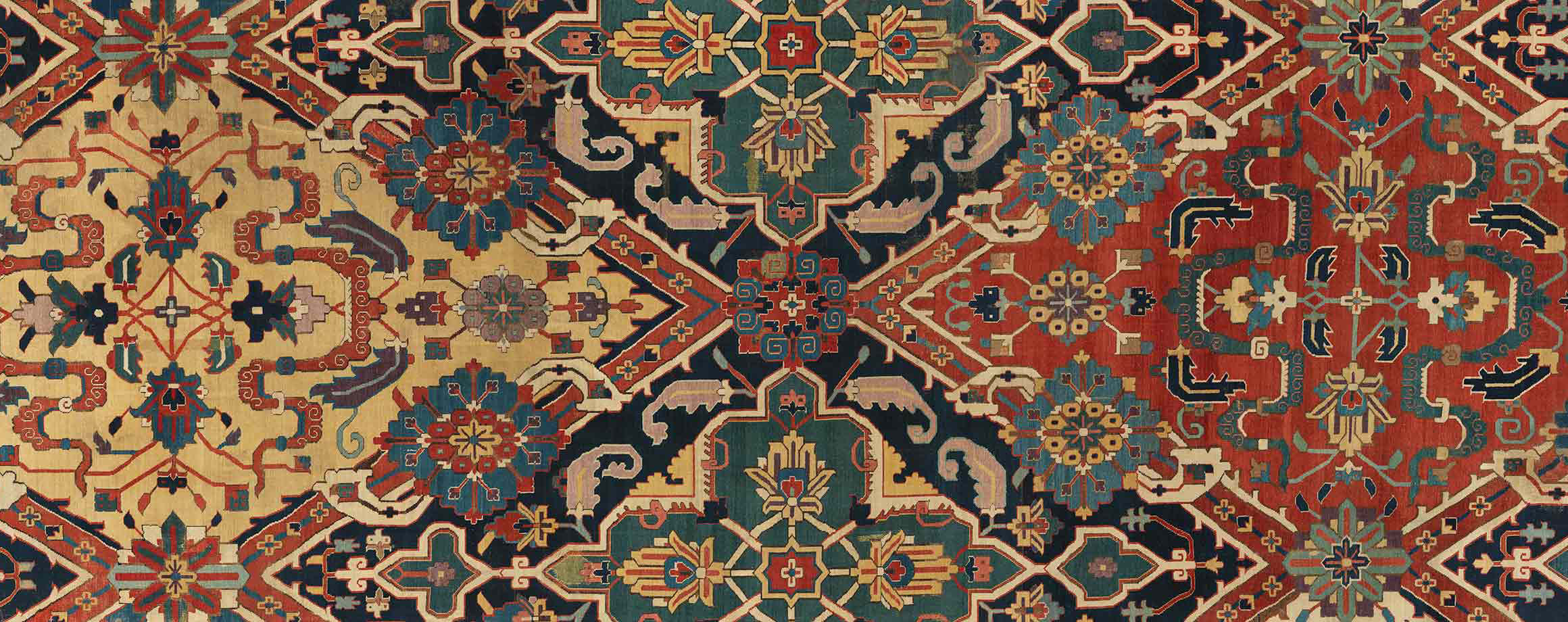
Textile Conservation Winter Colloquium 2018: Presentations and Research
On Friday, January 5, 2018, the Department of Textile Conservation hosted its Winter 2018 Colloquium, "Recent Presentations and Research," in the Bonnie J. Sacerdote Lecture Hall of The Met's Ruth and Harold D. Uris Center for Education.
The morning began with an introduction from Deputy Director for Collections and Administration Carrie Rebora Barratt, and continued with four presentations from five textile conservators at The Met. The afternoon concluded with a presentation about Azerbaijani carpets by a guest lecturer, Prof. Dr. Roya Taghiyeva, the former director of the Azerbaijani Carpet Museum.
The Deputy Director's welcome and the five presentations are featured below.
Carrie Rebora Barratt, Deputy Director, The Met
It is my great pleasure to welcome all of you today to the first annual colloquium offered by our esteemed Department of Textile Conservation. Founded in 1973, today it is the Met’s second largest conservation department, located in a state-of-the-art laboratory for maintaining our world-class textile collection that is housed at the Antonio Ratti Textile Center, the storage/study facility created in 1995.
Responsible preservation of textiles is the Department's fundamental mission. The current staff, led expertly by Janina Poskrobko, takes an object-centered approach emphasizing study of materials and techniques, acknowledging the importance of an integrated historical and scientific approach. Conservators and fellows from all over the world have trained here.
The Department has developed innovative methods for conserving, exhibiting and storing textiles from a wide range of cultures. Leaders in application of digital media for scholarly publishing on textiles, our conservators have also participated in cataloging the collection, creating a database available to millions of visitors and scholars online.
Today's speakers will cover a broad range of topics, each pertinent to best practice and creative enterprise in textile conservation and study.
Presentations (Abstracts and Video)
Julia Carlson, Assistant Conservator
Originally delivered at the International Council of Museums–Conservation Committee (ICOM-CC) Triennial Conference, Copenhagen, Denmark
An adhesive treatment is an established solution for fragile textiles. However, textile conservators often need to revisit these treatments because of ongoing advancements in theory and practice. This paper discusses an effective adhesive removal treatment on a late sixteenth- to early seventeenth-century Persian carpet (17.120.127) in the Islamic collection of The Met. After scientific analysis showed that the adhesive was a combination of a natural rubber and a triterpenoid resin, with additives and stabilizers, a series of tests were performed to find the most suitable removal process. Some of the adhesive was removed mechanically; the aged areas with more triterpenoid elements were removed with a 1:1 solution of 20% acetone/ethanol in 2% xanthan gel. The areas with mainly natural rubber were removed with 20% methyl ethyl ketone in 2% xanthan gel.
Janina Poskrobko, Conservator in Charge, and Yael Rosenfield, Associate Conservator
With contributions by Midori Sato, Conservator Emerita, and Nobuko Shibayama, Research Scientist in the Department of Scientific Research
The Emperor's carpet is one of the most important Safavid carpets in The Met's collection. It was recently conserved in preparation for display on its own custom-built platform in the newly redesigned Islamic galleries. The conservation treatment was one of the larger and more challenging projects in the Department of Textile Conservation and took over three years to complete. The carpet's weave structure, fibers, and dyes were analyzed in-depth. A comparison to other Safavid carpets of similar type has contributed to our understanding of their history and attribution.
Cristina Carr, Conservator
Close examination of a textile with the aid of a microscope reveals more than fiber type and weave structure. Images communicate visual information, perceptions of a material object, breathing life into an object by presenting an intimate view of core characteristics. Whether via a unique one-time image, a sequence of images, a video, or in the context of a systematic database, images can illustrate text but also convey visual information essential in the discussion of an object. Image-based social media platforms such as Pinterest and Instagram allow non-verbal sharing of visual information.
Textiles are three-dimensional objects resulting from a complex series of interrelated but independent actions, actions that do not necessarily have a set order. Visual communication permits a more layered thinking, following the path, both visible and conceptual, offered within the object itself.
Minsun Hwang, Conservator
In Korea, two distinct qualities of hemp cloth, andongpoh and musam, are woven for shrouds, funerary costumes, and everyday summer wear.
Andongpoh is indigenous to the southeast region of Korea, whereas musam is produced in eleven different regions. Andongpoh was traditionally used as an offering to kings and royal families, while musam was made solely for the Korean lower classes. This presentation will share the results of onsite research, funded by a grant from The Met, in Andong and Boseong County, including documentation of the hemp harvest and the complex, distinctive steps of the two types of hemp fabric production.
Prof. Dr. Roya Taghiyeva, Former Director of the Azerbaijani Carpet Museum
Presented by Umay Mǝmmǝdzadǝ
From ancient times, carpets have been an integral part of traditional culture and household in Azerbaijan. The Azerbaijani carpet has a centuries-long historical development.
Historically, the development of carpet ornaments in Azerbaijan has gone through four stages: ancient motifs resembling those seen on ceramic and metal items of the Bronze Age (third to second millennium B.C.); Islamic ornaments of the ninth to tenth century; motifs brought from Central Asia and the Far East in the eleventh to thirteenth century; and, finally, European-influenced patterns stemming from the eighteenth to twentieth century.
Azerbaijani carpets offer a variety of types. Kuba, Shirvan, Baku, Ganja, Kazakh, Karabakh, and Tabriz were the main centers which defined the basic design types of the Azerbaijani carpet. Azerbaijani carpets have become an important component of world culture and art, and enjoy popularity on a global scale.